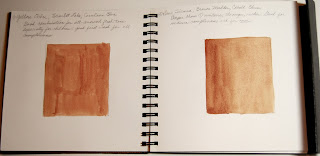I can also round up all the "floaties" and put them in the book and everything on color will be in one place.... well, almost everything on color. What about you? Do you keep notes on mixing colors and samples of different formulas? What do you keep yours in?
I hope you are starting a notebook on value... if so, here are even more tips that I found on a handout that I have.
- Place a middle value first for a better grasp of the whole range of value and to reveal light areas. Add darks last.
- Full value range paintings lack a dominance... omit unnecessary values.
- Take a black and white picture of your painting.
- A small halo of light accents an edge where it meets a dark. Conversely, a small gradation of darker value will relax the same edge.
- Keep middle value paintings in the #4 to #7 range... middle values hold a painting together. We need middle values in large areas or shapes for cementing. They are the walls that support your windows of light or upon which darks can be patterned.
- Dark value paintings should be kept in the #5 to #10 range. They give punch, drama and like light values can be used for structural unity.
- Light value paintings should be kept in the #1 to #5 range. Light values give life, breath and sparkle to a composition and can be used for structural unity.
- A photo of a sunlit subject usually blackens cast shadows. Lighten these and put more color into them.
- Alternate value contrasts along extended edges.
- It takes a value change to separate a tree from the sky. Don't rely on a color change to separate it. Even worse, don't rely on texture.
- Most brighter colors come to full intensity in mid-value
- Give most of your attention to the four to seven largest pieces of value in your painting. If these few large hunks are not the most distinguished shapes you can make, your painting will fail.
Be Still My Art,
Kay



No comments:
Post a Comment